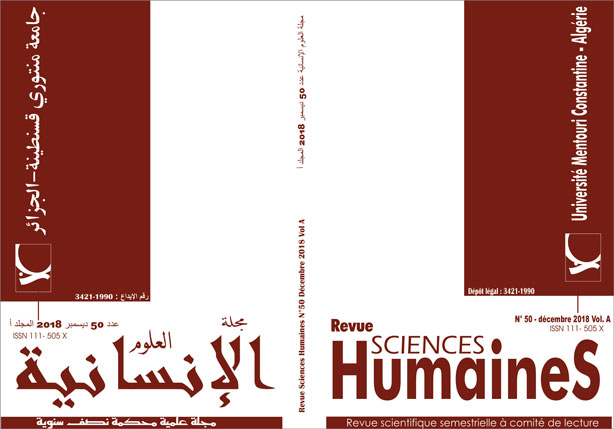Developing the Composition Skills of English as a Foreign Language Learners through Blended Learning
Keywords:
Composition Skills, Writing Skill, ICTs, Web 2.0., Blended Learning, Flipped ClassroomAbstract
Innovation and development in the sector of information and communication technologies have significantly impacted the field of education by offering new possibilities for learning and teaching, particularly in English Language Teaching. Dissatisfaction with the traditional teaching of writing and with e-learning has led to the emergence of a new instructional paradigm called blended learning. This paradigm has become very popular in many foreign countries, and more specifically in the Arab world. The purpose of this study is to investigate the effectiveness of blended learning in developing the composition skills of English as Foreign Language university students in an Algerian context. For this purpose, a quasi-experiment and an evaluation questionnaire are used as data collection tools. On the basis of the results obtained, some recommendations are provided.
Downloads
References
- (1)Adas, D., & Bakir, A. (2013). Writing difficulties and new solutions: Blended learning as an approach to improve writing abilities. International Journal of Humanities and Social Science , Vol. 3 (9), 254-266.
- (2) Ahmed, M. A. (2016). The effect of a flipping classroom on writing skill in English as a foreign language and students’ attitude towards flipping. US-China Foreign Language , Vol.14 (2), 98-114. doi:10.17265/1539-8080/2016.02.003
- (3) Al Khasawneh, F. M. (2010). Writing for academic purposes: Poblems faced by Arab posgraduate students of the College of Business, UMM. ESP World , Vol.9 (Issue 2-28), 1-23. Retrieved from: www.esp-world.info/Articles_28/WRITING.pdf
- (4) Alajab, A. M., & Hussain, A. M. (2015). The impact of a blended learning course on Khartoum University students. American International Journal of Social Science , Vol.4 (2), 132-158. Retrieved from: www.aijssnet.com/journals/Vol_4_No_2_April_2015/13.pdf
- (5) Albhnsawy, A. A., & Aliweh, A. M. (2016). Enhancing student teachers’ teaching skills through a blended learning approach. International Journal of Higher Education , 5 (3), 131-136. doi:10.5430/ijhe.v5n3p131
- (6) Aleksić, V., & Ivanović, M. (2013). Blended learning in tertiary education: A case study. Sun SITE Central Europe , 1036, 96-103.
- (7) Babo, R., Rodrigues, A. C., Lopes, C. T., de Oliveira, P. C., Queirós, R., & Pinto, M. (2012). Differences in Internet and LMS usage: A case study in higher education. In R. Babo, & A. Azevedo (Eds.), Higher Education Institutions and Learning Management Systems: Adoption and Standardization (pp. 247-270). Hershey, PA: Information Science Reference.
- (8) Baddeley, A. (2010). Working memory. Current Biology , 20 (4), 136-140. doi:10.1016/j.cub.2009.12.014
- (9) Bailey, D. R., Lee, A. R., Vorst, T. C., & Crosthwaite, P. (2017). An Investigation of Differences and Changes in L2 Writing Anxiety between Blended and Conventional English Language Learning Context. CALL-EJ , 18 (1), 22-39. doi: 10. 15702/mall.2018.21.1.11
- (10) Bates, T. (2014, December 10). A short history of educational technology. Retrieved November 2016, from www.tonybates.ca: https://www.tonybates.ca/2014/12/10/a-short-history-of-educational-technology/
- (11) Bergmann, J., & Sams, A. (2014). The flipped classroom. CSE , 17 (3), 24-27. Retrieved from: https://www.acsi.org/Documents/Professional%20Development/CSE17.3%20-%20Bergmann%20-%20The%20Flipped%20Classroom.pdf
- (12) Brown, H. D. (2001). Principles of Language Learning and Teaching. White Plains, NY: Longman.
- (13) Challob, A. I., Abu Bakar, N., & Latif, H. (2016). Collaborative blended learning writing environment: Effects on EFL students’ writing apprehension and writing performance. English Language Teaching , 9 (6), 229-241.
- (14) Chen, W. (2009). A study of using blended learning in teaching and learning modern educational technology. In F. L. Wang, J. Fong, L. Zhang, & V. S. Lee (Ed.), Hybrid Learning and Education. ICHL 2009. Lecture Notes in Computer Science. vol 5685, pp. 299-308. Berlin, Heidelberg: Springer.
- (15) Chilingaryana, K., & Zverevab, E. (2017). Methodology of flipped classroom as a learning technology in foreign language teaching. Social and Behavioral Sciences , 237, 1500 – 1504. doi: 10.1016/j.sbspro.2017.02.236
- (16) Clenton, J. (n.d.). Academic Writing: towards an integrated approach? Retrieved from http://www.sussex.ac.uk/languagedocument
- (17)Cohen, L., Manion, L., & Morrison, K. (2007). Research Methods in Education (6th ed.). New York, NY, USA: Routledge.
- (18) Danker, B. (2015). Using flipped classroom approach to explore deep learning in large classrooms. The IAFOR Journal of Education , III (I), 171-186. Retrieved from: https://eric.ed.gov/?id=EJ1100618
- (19) DeGregorio-Godeo, E. (2006). Resource centres, ICTS and self-access. Mélanges CRAPEL , N°28, 123-133.
- (20) El-Mowafy, A., Kuhn, M., & Snow, T. (2013). A blended learning approach in higher education: A case study from surveying education. In Design, develop, evaluate: The Core of the learning environment.Proceedings of the 22nd Annual Teaching Learning Forum, 7-8 February 2013. Perth: Murdoch University.
- (21) Forment, M. A., Guerrero, M. J., & Poch, P. J. (2010). Towards mobile learning applications integration with learning management systems. In T. T. Goh (Ed.), Multiplatform e-Learning systems and technologies: Mobile devices for ubiquitous ICT-based education (pp. 182-194). Hershey, PA: Information Science Reference.
- (22) Garrison, A. D., & Kanuka, H. (2004). Blended learning: Uncovering its transformative potential in higher education. Internet and Higher Education , 7, 95-105. Retrieved from: https://doi.org/10.1016/j.iheduc.2004.02.001
- (23) Geta, M., & Olango, M. (2016). The impact of blended learning in developing students’ writing skills: Hawassa University in focus. African Educational Research Journal , Vol. 4 (2), 49-68. Retrived from: http://www.netjournals.org/z_AERJ_16_022.html
- (24) Ghahari, S., & Ameri-Golestan, A. (2013). The effect of blended learning vs. classroom learning techniques on Iranian EFL learners’ writing. International Journal of Foreign Language Teaching & Research , 1 (3), 1-9.
- (25) Graham, S., Harris, K. R., & Olinghouse, N. (2007). Addressing executive function problems in writing. In L. Meltzer (Ed.), Executive function in education: from theory to practice (pp. 216-236). New York, NY: The Guilford Press.
- (26) Hamdan, N., McKnight, P., McKnight, K., & Arfstrom, K. (2013). A review of flipped learning. Retrieved January 2016, from https://flippedlearning.org/wp-content/uploads/2016/07/
- (27) Hamzaoui Elachachi, H. (2015). Exploring cultural barriers in EFL Arab learners’ writing. Social and Behavioral Sciences , 199, 129-136.
- (28) Harris, B. F., Harris, J., Reed, L., & Zehilic, M. (2016). Flipped classroom: Another tool for your pedagogy tool box. Developments in Business Simulation and Experiential Learning , 43, 325-333. Retrieved from: https://journals.tdl.org/absel/index.php/absel/article/download/3061/3010
- (29) Hasan, B. A. (2001). The relationship of writing apprehension and self-esteem to the writing quality and quantity of EFL university students. Mansoura University, College of Education, Pamietta, Egypt.
- (30) Hayes, J. R., & Flower, L. S. (1980). Identifying the organization of writing processes. In L. Gregg, & E. R. Steinberg (Eds.), Cognitive processes in writing (pp. 3-30). Hillsdale, NJ: Lawrence Erlbaum.
- (31) Horning, A. (2007). The definitive article on class size. WPA: Writing Program Administration , 31 (1-2), 11-34. Retrieved from: https://www.classsizematters.org/wp-content/uploads/2012/11/31n1-2horning.pdf
- (32) Jdeitawi, F. T., Noh, M. A., & Abdul Ghani, K. (2012). The relationship between self-esteem and learning reading and writing in sixth graders in the Hashemite Kingdom of Jordan. International Journal of West Asian Studies , 4 (2), 93-113. Retrieved from: http://ejournal.ukm.my/ijwas/article/view/14570
- (33) Keshta, A. S., & Harb, I. I. (2013). The effectiveness of a blended learning program on. Education Journal , Vol.2 (6), 208-221.
- (34) Kurtz, G. (2014). The flipped classroom approach: The answer to future learning? European Journal of Open, Distance and e-Learning , 17 (2), 172-182. Retrieved from: https://doi.org/10.2478/eurodl-2014-0027
- (35) Lee, M. J., & McLoughlin, C. (2010). Applying Web 2.0 tools in hybrid learning designs. In F. L. Wang, J. Fong, & R. C. Kwan (Eds.), Handbook of research on hybrid learning models: Advanced tools, technologies, and applications (pp. 371-392). Hershey, PA: Information Science Reference.
- (36) Lien, C. T. (2015, August 13-15). Enhancing writing skills for second-year English majors through a Moodle-based blended writing course: An action research at Hue University of Foreign Languages. Paper presented at the 6th International Conference on TESOL on Responding to Challenges of Teaching English for Communication.
- (37) Liu, M. (March 2013). Blended learning in a university EFL writing course: Description and evaluation. Journal of Language Teaching and Research , Vol. 4 ( 2), 301-309. doi:10.4304/jltr.4.2.301-309
- (38) Mayes, T., & Freitas, S. (2004). Review of e-learning theories, frameworks and models. JISC e-learning models desk study (1), 1-43. Retrieved from: https://curve.coventry.ac.uk/open/items/8ff033fc-e97d-4cb8-aed3-29be7915e6b0/1/Review+of+e-learning+theories.pdf
- (39) McLoughlin, C., & Lee, M. J. (2008). The three P’s of pedagogy for the networked society: Personalization, participation, and productivity. International Journal of Teaching and Learning in Higher Education , 20 (1), 10-27. Retrieved from: https://eric.ed.gov/?id=EJ895221
- (40) Melouk, M., & Merbouh, Z. (2014). EFL writing hindrances and challenges: The case of second year students of English at Djillali Liabes. Journal of Educational and Social Research , 4 (3), 149-156. Doi:10.5901/jesr.2014.v4n3p149
- (41) Molnar, A. (1997, January 06). Computers in education: A brief history. Retrieved May 2013, from thejournal.com: https://thejournal.com/articles/1997/06/01/computers-in-education-a-brief-history.aspx
- (42) O’Neil, H. F., & Perez, R. S. (2003). Technology applications ineducation: A learning view. Mahwah, NJ: LAWRENCE ERLBAUM ASSOCIATES, PUBLISHERS.
- (43) Papandreou, M. Z. (2016). Supporting Academic Writing Skills through Blended Learning. ITBE Link . Retrieved from: https://www.itbe.org/v_newsletters/article_65971793.htm.
- (44) Pashler, H., McDaniel, M., Rohrer, D., & Bjork, R. (2008). Learning styles: Concepts and evidence. Psychological Science in the Public Interest , 9 (3), 105-119.
- (45) Prensky, M. (2001). Digital natives, digital immigrants. On the Horizon . Retrieved from: https://www.marcprensky.com/writing/Prensky%20-%20Digital%20Natives,%20Digital%20Immigrants%20-%20Part1.pdf.
- (46) Ragupathi, K. (2014). Virtually Vygotsky: Using technology to scaffold student learning: By Adrian Lee. Technology in Pedagogy , 20, 1-9. Retrieved from: http://www.cdtl.nus.edu.sg/technology-in-pedagogy/articles/Technology-in-Pedagogy-20.pdf.
- (47) Regueria, N. R., & Rodríguez, J. R. (2015). The digital textbook underanalysis: A case study. In Z. Sikorova, M. Horsley, T. B. Garcia, & J. R. Rodríguez (Ed.), The Thirteenth international conference on research on textbooks and educational media (pp. 186-198). Ostrava – Czech Republic: LARTEM.
- (48) Sen, T. K. (2011). Application of blended and traditional class teaching approach in higher education and the student learning experience. International Journal of Innovation, Management and Technology , Vol. 2 (2), 107-109.
- (49) Singh, H. (2003). Building effective blended learning programs. Educational Technology , Vol.43 (6), 51-54. Retrieved from: http://asianvu.com/digital-library/elearning/blended-learning-by_Singh.pdf
- (50) Soliman, N. A. (2014). Using e-Learning to develop EFL students’ language skills and activate their independent learning. Creative Education , Vol.5, 752-757. Retrieved from: http://www.scirp.org/journal/ce
Staker, H., & Horn, M. B. (2012). Classifying K–12 Blended Learning. Innosight Instite. Retrieved from: https://www.christenseninstitute.org/wp-content/uploads/2013/04/Classifying-K-12-blended-learning.pdf
- (51) Sulisworo, D., Rahayu, T., & Akhsan, R. N. (2016). The students’ academic writing skill after implementing blended learning using Facebook. Information Technologies and Learning Tools , 56 (6), 176-191. Retrieved from: https://journal.iitta.gov.ua/index.php/itlt/article/view/1477
- (52) Trapp, S. (2006). Blended learning concepts – a short overview. In E. Tomadaki, & P. Scott (Ed.), Innovative approaches for learning and knowledge sharing: Proceedings of the First European Conference on Technology Enhanced Learning, EC-TEL, (pp. 28-35). Crete.
- (53) Vernadakis, N., Giannousi, M., Derri, V., & Michalopoulos, M. (2012). The impact of blended and traditional instruction in students’ performance. Technology , 1, 439 – 443.
- (54) Westbroook, C. (2014, May 07). Using Bloom’s Taxonomy to teach critical thinking in Unlock. Retrieved February 2018, from cambridge.org: http://www.cambridge.org/elt/blog/2014/05/07/using-blooms-taxonomy-teach-critical-thinking-unlock/
- (55) Yang, Y. (2010). Computer-assisted Foreign Language Teaching: Theory and practice. Journal of Language Teaching and Research , 1 (6), 909-912.
- (56) Yigit, T., Koyun, A., Yuksel, A. S., & Cankaya, I. A. (2014). Evaluation of blended learning approach in computer engineering education. Social and Behavioral Sciences , 141 , 807-812. Retrieved from: https://doi.org/10.1016/j.sbspro.2014.05.140
















